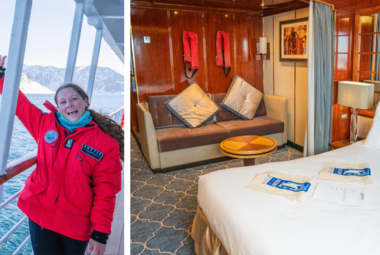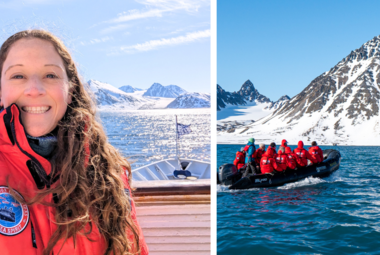After two expedition cruises to Antarctica and the Arctic, I’m finding it hard to book sailings on massive, mainstream cruise ships.
Like many cruisers, I took my first-ever cruise on a large ship to the Caribbean. The vessel could accommodate over 4,000 passengers, and it had an overwhelming amount of things to do onboard, including water slides, three pools, multiple restaurants, and a variety of production shows.
As an avid traveler, my first cruise experience evoked a sense of adventure within me. Visiting a new port each day without having to plan transportation logistics myself was unlike any type of vacation I had done before.
Related: Are cruises worth it?
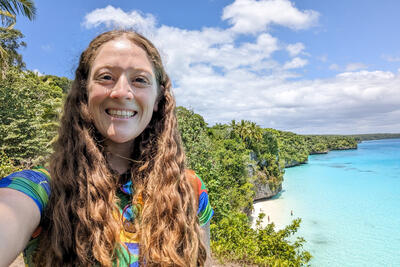
Following my first cruise, I took over twenty more sailings on mainstream cruise ships, which accommodated between 2,000 and 7,000 passengers. I traveled to some of the world’s most dreamy destinations—from Alaska to the South Pacific—exploring dozens of countries along the way.
Even still, I always felt like something was missing.
It’s hard to immerse yourself in the destination on a traditional cruise ship
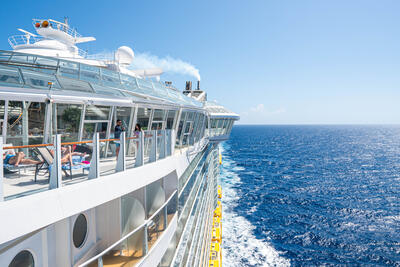
My favorite aspect of traveling is fully experiencing the destinations I visit, and unfortunately, this can be difficult to achieve when cruising on a mega-ship.
Regardless of how fun the ship’s rock climbing wall and Broadway shows can be, the limited time in ports—which might see up to 10,000 passengers a day—is a major con of cruising for me.
So when I took my first expedition cruise last fall—a 9-night sailing to Antarctica by polar operator Poseidon Expeditions—I quickly became hooked on expedition cruising.

My time on the Sea Spirit, a ship with just over 100 guests, was the most immersive cruise I had ever experienced, and there were no crowds to speak of onboard or ashore—unless you count the penguins.
I loved my Antarctic experience so much, in fact, that I booked a second expedition cruise on the Sea Spirit—this time to the Arctic—just six months later. The itinerary, which brought me from Edinburgh to Svalbard, further reinforced my preference for expedition cruising over traditional cruising.
Here are 8 reasons why.
First, expedition vessels carry far fewer passengers than mega-ships

One of the most significant differences between an expedition cruise and a traditional cruise is the amount of passengers onboard.
It’s easy to feel like just a number when cruising on a ship with 6,000 or 7,000 passengers. During my recent sailing on Royal Caribbean’s Icon of the Seas, the world’s biggest cruise ship, my experience was not exactly personal. Crew members could never have the capacity to learn thousands of names each week, and navigating the ship’s crowds was far from relaxing.

Compared to 7,000 guests, my Antarctic expedition cruise had only 107 passengers onboard, and just 72 guests were aboard for the Sea Spirit’s Arctic itinerary. At maximum capacity, the ship can only accommodate 114 passengers.
Sure, the Sea Spirit is significantly smaller than a ship like Icon of the Seas, but I never once felt like just a number on the vessel.
Related: I took a cruise on a ship with 107 versus 7000 passengers: here's how they compared
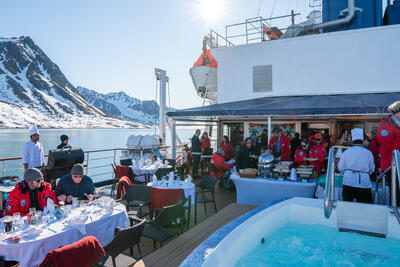
The staff learned my name in just a few days, and I made more friends on two expedition cruises than on twenty traditional cruises combined.
The family feel of an expedition cruise is hard to beat.
Expedition guides provide expertise on the region, whether giving lectures onboard or guiding guests ashore

Perhaps my favorite part of expedition cruising is interacting with the cruise line’s expedition guides.
One of the major differences between a mass-market cruise line like Royal Caribbean and an expedition line like Poseidon Expeditions is the presence of expedition guides. On my Arctic cruise, there were over a dozen specialized guides onboard, ranging from a geologist to a kayak guide, a botanist, and even a rifle master to keep us safe from polar bears.
Expedition guides are experienced in the Earth’s polar regions, with most having traveled to the regions dozens—even hundreds—of times. Nearly half of Poseidon Expeditions’ guides on my Arctic itinerary live full-time in Svalbard, making them experts on the region’s geography, history, flora, and fauna.

Expedition guides give lectures on relevant topics, from wildlife lectures about walruses and orcas to historical lectures about early expeditions to the South Pole. In addition, the guides bring guests ashore, leading hikes and zodiac cruises. They are always available to answer questions, too, whether when whale watching with guests on the promenade deck or sharing a meal at breakfast.

After two expedition cruises, I find myself missing the presence of expert guides while sailing on mass-market vessels. Although some lines like Princess Cruises bring guest lecturers onboard in destinations like Alaska, these lectures don’t remotely compare to the consistent, personalized interactions with expedition guides.
Food is of higher quality on expedition ships, with easy ability to customize dishes

Another difference I’ve noticed between expedition and traditional cruises relates to dining. Generally speaking, the food is of higher quality on expedition ships, and menu dishes are typically more elegant than those on mass-market lines.
I have never had major issues with a cruise line’s food, even when sailing on cruise lines like MSC, whose food commonly receives poor reviews.
That being said, I would pick the food on an expedition cruise over a large ship any day. Simply put, cooking for a maximum of 114 passengers versus several thousand leads to huge differences in food quality.

Dishes on the Sea Spirit were highly customizable. Breakfast and lunch, for example, were served buffet style, but if the buffet options didn’t catch your eye, you could order a custom dish from the live cooking stations, which rotated daily.
These cooking stations are not unique to expedition cruises; I often order made-to-order omelets and stir fry on traditional cruise lines. The difference, however, is that the wait times are much shorter with a few dozen guests versus a few hundred!

Dinner was served with table service, and offered a variety of “classic” options like steak and fish, but also more upscale choices including duck a l’orange and pineapple ceviche. Select evenings even offered champagne sorbet as a palate cleanser before the main course, something I had never seen on a traditional cruise line before.
One evening, none of the dishes stood out on the menu, so I asked the head chef if I could have a simple pasta dish instead. To my surprise, he made family-sized portions of spaghetti aglio e olio for our table, and the dish was divine.

I couldn’t even imagine asking for a custom-made, family-sized dish on a mass-market ship. This stellar, personalized service reinforced my preference for expedition cruise lines like Poseidon Expeditions over traditional lines.
Most shore excursions are included in the cruise fare, and excursions tend to be active—you can hike, kayak, or even camp ashore
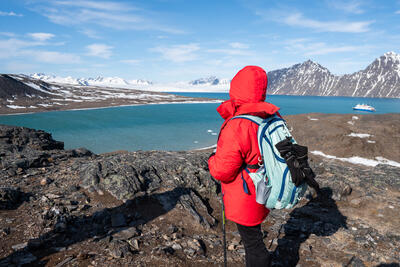
Call me crazy, but my idea of a vacation leans more toward active adventures than simply lounging on a beach. From trekking through the Sierras to cycling in Italy, I’m happiest when keeping active, and this type of traveling also allows me to discover a region more in-depth.
Something I love about expedition cruising is the adventurous nature of time ashore. Poseidon Expeditions typically offers a morning and afternoon activity each day at different landing sites. Depending on the site, guests could enjoy a tranquil walk around a frozen lake, trek through the snow up a mountain, or kayak amongst colossal, sparkling icebergs.

Of course, passengers aren’t required to participate in active excursions. Passengers with physical limitations, or those who simply want to take it easy, are welcome to stay near the landing site ashore, taking in the wonderful views without breaking a sweat.
I also appreciate that Poseidon Expeditions includes the vast majority of activities in the cruise fare. The only activities that cost extra are kayaking, camping, and optional city tours on disembarkation day. Everything else is included, making the cruise far more inclusive compared to traditional cruise lines with pricey excursions.
Related: 10 tips for getting the best cruise shore excursion values
Opportunities to see wildlife are abundant, from penguins to polar bears
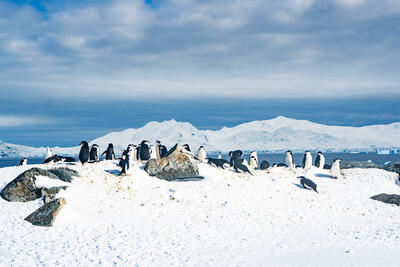
Who knew penguins could be so entertaining? This was a question I asked myself countless times during my first expedition cruise to Antarctica, and by the end of the cruise, I found a new passion for wildlife travel.
Expedition cruises place a high importance on discovering nature in its natural state. You won’t spend time ashore at beachfront resorts or aquariums. Instead, you can witness unique, rare wildlife in its natural habitat.
Although spotting wildlife is never a guarantee, you’re essentially guaranteed to see penguins in Antarctica. Rookeries are found virtually everywhere along the peninsula, in addition to diverse species of whales and seals.
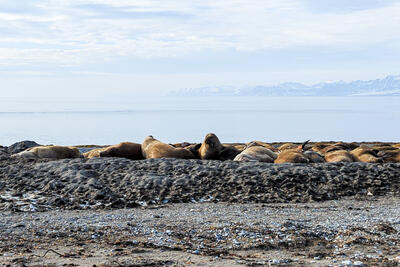
The Arctic boasts its own wildlife, including polar bears, Arctic foxes, reindeer, and walruses.
During my itinerary, we were lucky enough to see two polar bears feasting on a carcass, and the experience was truly unforgettable.
Sure, you can book wildlife tours on traditional cruises, but it’s difficult to guarantee wildlife viewings, especially with such a short time frame. An expedition cruise means you’re up close and personal to nature for several days in a row. This gives you a higher chance to spot some of Earth’s most fascinating creatures.
Many guests cruise solo on expedition vessels, and it’s easy to make friends onboard

Traditionally, most mass-market cruise lines cater to couples and families—these demographics make up the vast majority of passengers on cruise ships. Those cruising solo, unfortunately, are often subject to paying a single supplement fee. This fee is designed to make up for the cost of a “missing” second passenger in the cabin, unless they’re lucky enough to snag a coveted single room.
Beyond the single supplement fee, sailing solo on a traditional cruise can feel lonely. After taking four solo cruises myself, I’ve typically found it difficult to make friends onboard, as most passengers tend to stick around their own group.
Expedition cruising, on the other hand, is extremely friendly to solo cruisers. From 27-year-old engineers to 80-year-old grandmas, one of the biggest surprises I encountered on my Antarctic and Arctic expeditions was the amount of guests traveling solo.
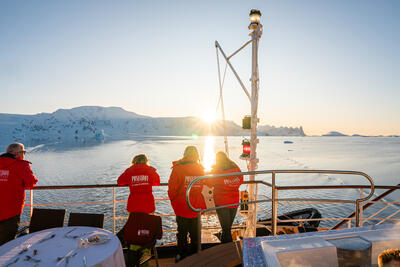
By design, expedition cruises foster an environment to bond with fellow passengers, making the experience less lonely for solo travelers.
First, most solo passengers on expedition cruises choose to share a cabin with other solo guests. Not only does this allow solo travelers to pay less for their cabin, but it often leads to a great friendship with the other passenger.
Outside the cabin, the main dining room on Poseidon Expeditions had open seating, which meant you could meet new guests every day. Activities ashore also fostered bonding with other passengers, whether marveling at a glacier or completing a challenging hike together.

Although I traveled with a guest on both itineraries, I wouldn’t hesitate to book a solo expedition cruise. In my experience, passengers aboard expedition cruises are friendly, adventurous, and open-minded, and I doubt I would ever feel lonely cruising solo on Poseidon Expeditions.
Cabins are larger and more comfortable than a standard mega-ship cabin
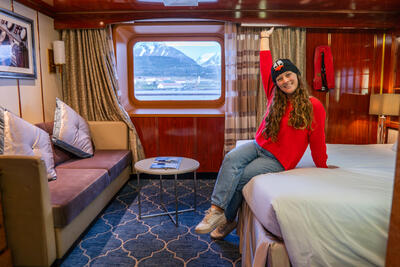
Cruise cabins tend to be small, with the tiniest of interior, windowless cabins as small as 150 square feet. While bigger than a closet, standard cruise cabins are not known for providing ample space.
This, of course, leads many passengers to book more expensive rooms, such as balcony cabins and suites. Whereas an interior cabin may cost $1,000 per passenger on a 7-night sailing, a balcony can easily cost double that, and even a basic suite could cost over $3,000 per person.
My Poseidon Expeditions cruise cabins, though, have both been significantly more spacious than cabins I’ve called home on ships like Royal Princess and MSC Seaside. In Antarctica, I sailed in a Superior Suite at 215 square feet, and my Classic Suite in the Arctic measured 226 square feet.
Related: Take a look inside my cruise cabin to Antarctica that cost $1,340 per night

The difference between a 140-square-foot and 215-square-foot cabin may not seem significant on paper, but on a ship, any extra space is a major plus. Additionally, the cabin felt more adequate for an expedition cruise, as it featured plenty of storage for accessories like our Poseidon Expeditions parkas, gloves, hats, binoculars, and camera gear.
Related: Top 25 cruise cabin hacks to improve your stateroom's functionality
Embarkation and disembarkation ports are unique, and they’re a nice “bonus” in addition to the cruise itinerary

Finally, the last reason I prefer expedition cruising over traditional cruising is the location of embarkation and disembarkation ports.
I’ve lost count of the number of times I’ve cruised from popular ports like Miami, Fort Lauderdale, and Seattle. Most cruise ships in North America leave from a handful of ports, and if you cruise frequently, you’ll rarely get the chance to visit a new embarkation city.
Even across the pond, most large vessels leave from cities like Rome, Barcelona, Southampton, and Athens. While there’s nothing wrong with these world-class destinations, they are cities I’m likely to visit without taking a cruise.
Yet when embarking or disembarking from an expedition cruise, you can expect the ports to be far further off the beaten path. Just getting to and from the expedition ship can be an adventure.
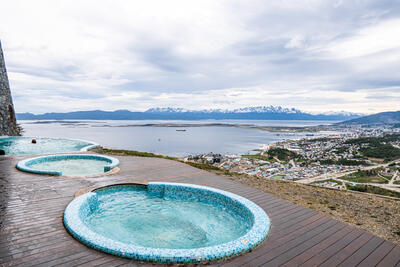
My Antarctica cruise, for instance, departed from Ushuaia, Argentina, the southernmost city on Earth, and my Arctic cruise ended in Longyearbyen, the northernmost city on Earth. Without having booked an expedition cruise, I would be far less likely to find myself in these destinations.
Having the chance to visit Patagonia’s rugged landscapes, wander the colorful streets of Buenos Aires, and discover daily life in Svalbard were all highlights of my expedition cruise experiences—and they occurred outside of the scheduled itinerary!
I always jump at every opportunity to visit new destinations, and expedition cruises provide that opportunity each and every day.
Feeling inspired to visit the Arctic and Antarctica with Poseidon Expeditions yourself next season? Get an additional discount of $500 USD for cruises in the 2024/25 Arctic season and 2024/25 and 2025/26 Antarctic season by using the code #JENNA500 when booking.
For more details on expedition cruise offerings, contact Poseidon Expeditions directly.




